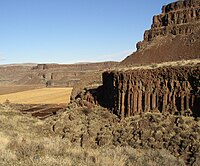
Photo from wikipedia
Abstract Island-arc accretion during the assembly of Gondwana has been widely regarded as the main mechanism for Neoproterozoic crustal growth in the Arabian-Nubian Shield (ANS). However, processes involved to transform… Click to show full abstract
Abstract Island-arc accretion during the assembly of Gondwana has been widely regarded as the main mechanism for Neoproterozoic crustal growth in the Arabian-Nubian Shield (ANS). However, processes involved to transform the newly accreted juvenile terranes into a typical continental crust remain unclear. Here, we present geochemical, isotopic, and U-Pb geochronological data from the El-Shadli volcanic province (80 km × 35 km and > 10 km thick) in the Eastern Desert of Egypt, which lies in the north-western part of the ANS, and overlies strongly deformed, previously accreted arc terranes. The El-Shadli volcanic province consists mainly of a mafic-felsic bimodal suite and subordinate intermediate rocks that intrude the mafic rocks of the suite. The bimodal suite rocks are tholeiitic, whereas the intermediate rocks have a calc-alkaline affinity. The bimodal suite and the intermediate rocks both yield U-Pb zircon ages of ~ 700 Ma implying they are coeval. High zircon eHf(t) values for the bimodal suite (average eHf(t) = +11.46) as well as the intermediate rocks (average eHf(t) = +9.76) indicate they were either magmatic extractions derived directly from a depleted mantle source, or the products of remelting of juvenile crust. Oxygen isotope data for zircon yield similar δ18O values for both the bimodal suite (average δ18O = 4.94‰) and intermediate rocks (average δ18O = 4.79‰). These are lower than typical mantle values indicating the parental magma in both cases interacted with hydrothermal fluids. Based on the petrological, geochemical, and isotopic data, we suggest that the El-Shadli bimodal suite and the intermediate rocks were produced by reworking of MORB-like and arc-like oceanic lithosphere, respectively, most likely driven by a mantle plume during the break-up of Rodinia. The recognition of the El-Shadli volcanic province as a likely mantle plume-induced post-kinematic magmatism provides a mechanism for the transformation of newly accreted juvenile crustal terranes into a chemically stratified normal continental crust. In addition, such plume events may result in new mantle extractions that are converted into new continental crust.
Journal Title: Precambrian Research
Year Published: 2021
Link to full text (if available)
Share on Social Media: Sign Up to like & get
recommendations!